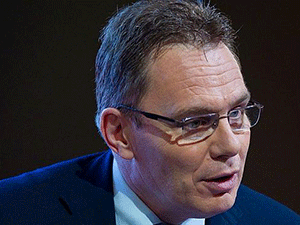
[miningmx.com] – IF anyone was harbouring hopes the global mining industry would begin to recover from its three-year meltdown this year, then the first few weeks of January disabused them of their fancy.
2014 was a sobering year for the mining sector characterised by austerity cuts, write-downs, retrenchments, refinancings and promises of better things to come. CEOs and management had heard the call of investors. It was time for pay-back after years of chasing volume over substance.
Then on January 15, the price of copper collapsed 16%, a particularly alarming development since the red metal was, of all metals, considered to have the most robust of prospects, especially in China where a medium-term supply deficit underpinned confidence.
Coming off the slide in crude oil to half its $99 per barrel average of 2014, it now appeared no metal was sacrosanct. One of the catalysts appeared to be an adjustment by the World Bank on January 13 that global economic grow would be 3% in 2015 rather than the 3.4% it had earlier forecast.
Interestingly, much of the selling pressure in copper originated in China. This is an important signal because it points to how far the world’s mining economy has come to rely on Chinese investment appetite as well as Chinese consumption.
“Understanding Chinese market sentiment has never been as important in determining commodity moves,’ said Macquarie Research in a January 7 report. “Never before in measured history has a single economy been as important for both current consumption and consumption growth on a five-year view,’ it added.
If Macquarie is right – and no-one disagrees with the role played by China in the commodities sector – then news that China’s economic growth would slow to around 7% this year, from double-digit growth in 2010, is the cornerstone fact you need to know about the prospects for mining investment in 2015.
Rajat Kohli, global head of mining and metals for Standard Bank, said in Johannesburg on February 2 that 2015 would continue to be a difficult year for mining companies. “It will be another cautious year,’ he commented. Kohli perhaps even under-cooked the extent of the fall-out yet to come before the sector is fully shriven of its 12-year bull market excess.
Investors don’t have far to look to see evidence that the mining sector is still struggling to recover. Only weeks into the new year, Anglo American gave notice of its continued financial distress saying it was likely to impair some assets in its “bulk’ portfolio such as iron ore and coal. The impairments duly materialised on Friday (February 13) with some $3.5bn relating to its Rio Minas project of a total of $3.9bn in write-downs.
A day after Anglo American’s announcement, another JSE bellwether, Sasol, said it would delay a gas-to-liquids investment at its Lake Charles complex in Louisiana, a project analysts said would require a much higher oil price to succeed.
Sasol also promised to make further in-roads into its R2bn, three-year cost cutting drive – a declaration that talks directly to investor fears the petrochemical firm’s dividend is at stake.
And a day after the Sasol shock, Glencore announced plans to shut half of its production at Optimum Colliery in Mpumalanga province citing “financial hardship’. Analysts speculated at the time that it would cut $1bn to $2bn in capital spending in order to cover its dividend.
That too was not an unfounded fear: on February 11, the group cut capex $1bn to between $6.5bn to $6.8bn from the $7.9bn it provided as a guide on December 10. If Glencore was caught napping in a mere 1.5 months, how is the rest of the market going to cope. It appears no-one is exempt.
AUSTERITY UNDER-COOKED
It’s worth remembering that throughout 2014 the mantra in the mining sector was shareholder returns with every major (and minor) mining firm publishing plans to cut costs. Given fresh fears about the ability to pay dividends among some companies, does this mean the austerity has not worked, and another round of cost-cutting is necessary?
Said Kohli: “Investors have been disappointed by the mining sector with many projects heavily over-capitalised, especially in the gold sector which has been reflected in the performance of gold equities.
“The basic message is that investors remain cautious of the sector and money continues to be rotated out in favour of other sectors such as telecommunications’.
For South African investors in mining assets there are, of course, additional headwinds connected with the country’s regulatory, political, and social and labour complexities which add to the macroeconomic problems afflicting the mining sector at large.
Allan Cooke, a precious metals analyst for JP Morgan, was withering in his assessment of the “challenges’ affecting South Africa’s precious metals industry.
In a note published on January 26, he said the key risks of operating in South Africa included “… a difficult labour climate, potentially fractious wage negotiations later this year, Eskom’s generating capacity and funding issues, ongoing regulatory uncertainty, cost inflation (labour and power), and moribund productivity’. It almost seems too much to absorb.
Mike Teke, president of the Chamber of Mines, acknowledged the problems. “A major challenge is our energy situation which spills over into investor confidence,’ he said of the regular load-shedding rolled out by Eskom which feeds directly into industry. “You say things are happening in South Africa, but then you look at the energy situation,’ he said.
“We also just don’t understand how big a problem low productivity in South Africa is while the whole labour relations environment is tough. When we have wage negotiations we have to do it in a mature manner.
“Taking things from the negotiating room into the streets is a big problem for us,’ he said. It’s worth noting annual wage negotiations in the South African gold sector are due to begin in May or June.
“So the response is that we need to ensure our messaging is right in terms of creating investor confidence. We need to start speaking the same language. Let’s talk about SA Inc,’ he said.
PRIVATE CAPITAL
Hanre Rossouw, head of resources: frontier and emerging markets at Investec Asset Management, said there’s further pain to come for mining sector investors. “I can see the market has to go down another leg which will probably mean dividend cuts from BHP Billiton, Anglo American and Sasol,’ he said. “Maybe not doing the share buy-back was a good idea by BHP.’
Rossouw is referring to investor disappointment last year when BHP decided not to buy-back shares electing instead to roll out shares in its proposed demerged company, South32 to shareholders instead.
The proposed demerger of BHP Billiton’s assets – most of which are the smaller businesses owned by the group in South Africa, Mozambique, Colombia and Australia – will be watched eagerly by the rest of the mining world. Will investors warm to the improved management focus given to so-called non-core assets?
Anglo American Platinum, for instance, has suggested it may spin out its Rustenburg shafts into a separate company should it fail to attract good enough bids for them in terms of its restructuring plans.
The feeling is parent company, Anglo American, is in no hurry to sell the shafts believing the market may improve. If it doesn’t, however, a spinoff on the Johannesburg Stock Exchange is a possibility.
Transactions of this ilk are exactly the kind of consequence of a difficult market that Standard Bank’s Kohli believes will be a characteristic of the current mining market. With only $45bn in mining transactions last year, deal-flow was the lowest in six years.
“Owing to funding challenges this year to all but the most robust companies, and with debt markets being so expensive, we expect there to be more M&A this year,’ said Kohli. He also raised the prospect that, finally, private capital could grasp the nettle and buy up some of the assets major miners believe are non-core.
There is, therefore, hope that the mining market’s recovery has been delayed a year. “It’s a cyclical market, we all know that,’ said Kohli. “Right now, we’re in a trough,’ he said.
It’s no coincidence that in October, former Xstrata CEO, Mick Davis, and founder of X2 Resources was able to raise a further $1bn from private sources taking the firm’s total warchest to $4.8bn of which $3.3bn was in committed equity capital.
Speaking in May, Davis said: “A combination of the fact that the complexity of investment, the retrenchment of growth capital, and declining grades means that we’re probably entering a period of constrained supply. For me, it’s just a very simple equation that translates into again a period of sustained rising prices’.
Said Kohli earlier this month: “There is quite a lot of private capital waiting in the wings. What may make them more prominent this year is that public equity and debt markets are more challenging.
“I feel we’re in a trough. This encourages private capial to have a more realistic go at these assets,’ he said. He estimated that of the $20bn raised by private capital for mining investment, some $18bn could be deployed in the coming year.
According to Macquarie, it’s not logical to tar the entire mining sector with the same brush. “We consider base metals the best of a bad bunch … while for bulk commodities (coal, iron ore) the need to cut immediate supply persists,’ it said.
“Precious metals are struggling to recapture investor interest though prices have better upside than downside potential,’ it said.
Look no further than the JSE where the gold index is 33% higher at the time of writing. According to Cooke, this is rand/dollar driven, with the expectation that the rand will fall to R11.80/dollar by the year-end, supporting revenue for South African gold stocks.
“Meanwhile, the quiet restructuring of the global steel industry means the important first steps in the long road back to health have been established,’ Macquarie said in its report.
Jonathan Moore has a particular interest in the commodities market. As vice-president and MD of Mining Indaba attendance numbers at the flagship mining conference in Africa rises and falls as the market waxes and wanes. There were some 7,000 conference delegates this year, roughly in line with 2014, although attendees said they noticed it to be palpably quieter.
“What I do know is that people far smarter than me have very divergent views on where the market is going this year,’ he said. “I think on balance, 2015 may be marginally better than 2014, but the challenges that will crop up will be very different sector to sector,’ he said.










